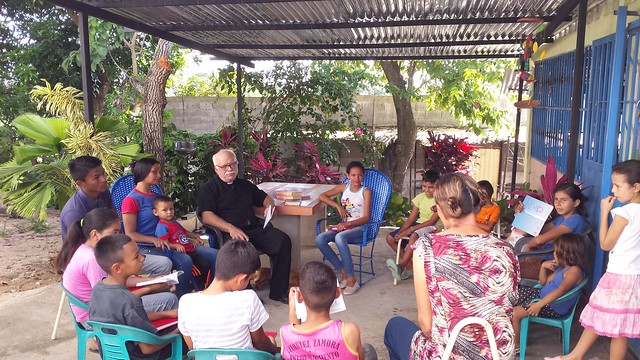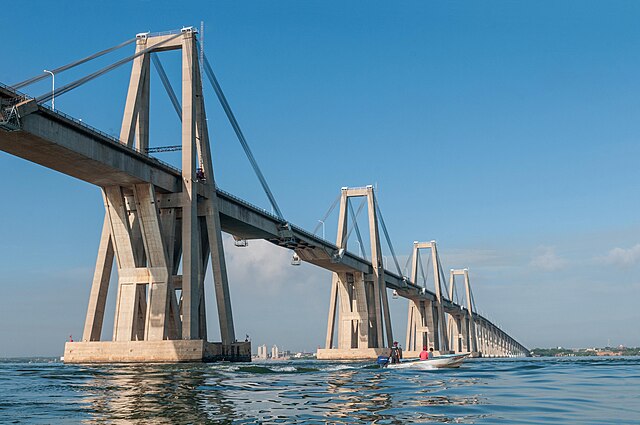 |
| Venezuela's Rio Caroni |
Heavy
rains have caused severe floods in states along the Venezuela’s
major rivers, such as the Orinoco, resulting in extensive
property danage and loss of electricity, telephone, Internet and
other basic services. Thousands have been left homeless as the river
has overflowed its banks to record levels. Swamped streets and homes
provide more habitat for mosquitoes, furthering the spread of
diseases like malaria and dengue fever at a time when medicines are
in short supply. The floodwaters also have brought with them
anacondas and other river-dwelling snakes.
Maracaibo,
Venezuela’s second-largest city with a population of about 2
million people, is located on the western shore of the strait that
connects Lake Maracaibo, the largest lake in South America, with the
Gulf of Venezuela in the Caribbean Sea. The city’s lifeline is the
General Rafael Urdaneta Bridge, a 5.3-mile-long structure that
connects Maracaibo with the rest of the country. In early August, a
fire destroyed a transformer on the bridge and it was closed, leaving
the city without power for several days. News
of a collapsed bridge in Genoa, Italy, raised fear that the
Maracaibo bridge also might collapse, since both bridges were
designed by the same engineer. On August 31, tranformers
exploded at an electrical substation, further frustrating efforts
to restore power to Maracaibo. There are reports of people
eating spoiled meat as a result of lack of electricity for
refrigerated storage.
Also on Friday,
August 31, most of Caracas, the national capital and largest city,
was left without electricity in the second such outage in 24 hours.
The city has been suffering chronic shortages of water as the
system designed to supply water to the high-altitude capital has
deteriorated.
On August 21, a
7.3-magnitude earthquake occurred off Venezuela’s northeastern
coast. The impact was felt in five Venezuelan states and some
Caribbean islands. There
was some property damage, but no loss of human life.
Here in La Caramuca,
our main concern remains the country’s continuing economic crisis.
The government has issued new
currency with five decimal places erased in effort to solve the
problem of having to hand over stacks
of inflated bills for the simplest cash transactions. Yet very
little of the new currency is available in our area. Prices are now
posted according to the new currency, so we have to calculate the
equivalent in the old currency (which amounts to millions of
bolivares).
 |
| New patio roof. |
Nevertheless, we
press on with preparations for the new school year which begins on
September 14. There is a new roof over part of the patio to provide
additional protected space for Luz Maria’s afterschool tutoring.
And no more iguana droppings during Sunday Bible class.
Adios, Edie Jorns
During the Sept. 2
Sunday service, we give thanks for the life and work of Edie Jorns,
who passed away on August 28. Since 2006, children from La Caramuca
have received Christian education scholarships from LeadaChild,
the mission society that Edie and her husband, Jim, founded after
serving as Lutheran Church-Missouri Synod missionaries to Guatemala
in the 1960s. LeadaChild, originally called Children’s Christian
Concern Society, at first was organized to support a school in
Guatemala (now named after Edie Jorns), but now supports projects in
22 countries, including Venezuela. I had had heard of Edie and Jim’s
work while I lived in their native state of Kansas, but it was not
until 2006 that Luz Maria and I both got the chance to meet them.
Edith
L. Jorns was born on January 5, 1933 in Topeka, Kansas, to Walter
T. and Anna Schmid. He graduated from Topeka Lutheran School and
Topeka High School. She received her bachelor’s degree from Kansas
State University, Master of Social Work from the University of North
Carolina Chapel Hill and a PhD in adult education from Kansas State
University. In addition to her work with LeadaChild, Edie worked as a
school social worker until her retirement in 1996. She was
instrumental in helping to establish the Kansas Association of School
Social Workers and was its first president. She was recognized as the
Association’s School Social Worker of the Year in 1986-87. An
active member of St. Luke’s Lutheran Church in Manhattan, Kansas,
Edie served on many boards and committees, as an organist and Sunday
School teacher and in the Lutheran Women’s Missionary League. She
is survived by her husband, their children and grandchildren.


No comments:
Post a Comment